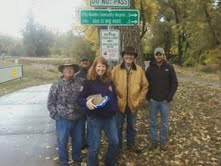
 Boulder Flycasters is participating in many local and regional youth fishing clinics this spring and we need volunteers to help with the youth presentations. We partner with the Colorado Parks and Wildlife to man various stations educating children from ages 3 to 16 in areas such as fish habitat, game species, fish anatomy, regulations and more. No one needs to be an expert, Parks & Wildlife provides large education easel board presentations that are easy to use. In addition to the clinic presentations, we also help with casting and fishing at many of the clinics as well.
Boulder Flycasters is participating in many local and regional youth fishing clinics this spring and we need volunteers to help with the youth presentations. We partner with the Colorado Parks and Wildlife to man various stations educating children from ages 3 to 16 in areas such as fish habitat, game species, fish anatomy, regulations and more. No one needs to be an expert, Parks & Wildlife provides large education easel board presentations that are easy to use. In addition to the clinic presentations, we also help with casting and fishing at many of the clinics as well.
Please volunteer today to help with one or more of the clinics listed below. The clinics typically last only 2-3 hours and it is very rewarding time spent teaching our fishing and conservation skills to the next generation.
- Louisville Fishing Clinic: Saturday, 4/27/2013, at Warembourg fishing pond north of Cherry street
- Broomfield/Westminster Fishing Clinic: Saturday, 5/4/2013, at Metzger Pond
- Erie Fishing Clinic: Saturday, 5/11/2013, Thomas Reservoir
- City of Boulder Children’s Water Festival: Wednesday, 5/15/2013, CU Campus
- City of Boulder Water Conservation Fair: Saturday, 5/18/2013, East Boulder Rec Center
Please contact Larry Quilling for more information or if you’d like to volunteer.
Larry QuillingBFC Youth Coordinator
303-579-0656











